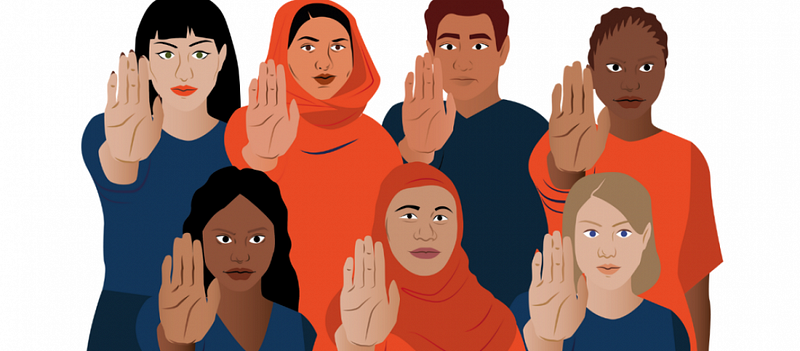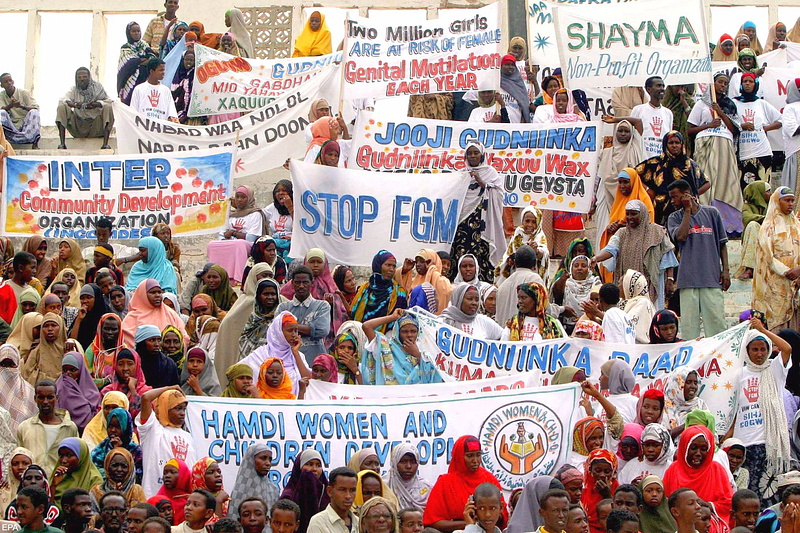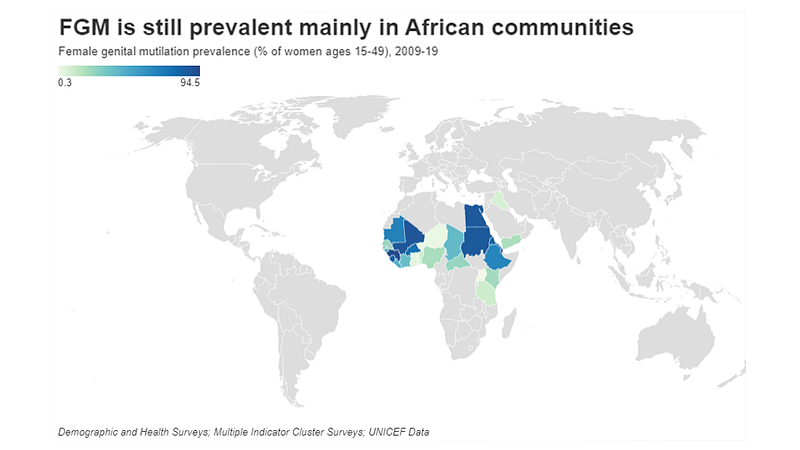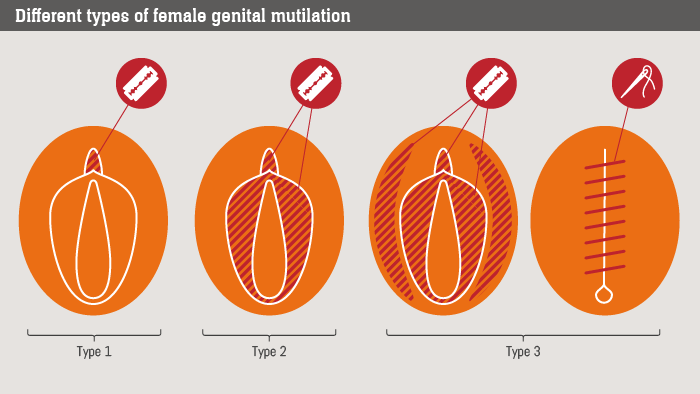Female Genital Mutilation : A Human Rights Violation
The story of Soumayya

The story of Soumayya
Let us adopt a more humanitarian and personal approach to this highly qualitative article.
Let us talk about that woman who was shackled down to a table and had her most private sanctuary probed open and tortured. You do not recover from that; at least not psychologically. Your life gets dotted by the insane amount of trauma that both your body and your mind goes through.
One eye-opening story that will traumatise you to the core is the story of Soumayya. Due to the complications of FGM and the over worldly pain that it brings during childbirth, her mother died giving birth to her. Consequently, her dad refused to put her daughter through the same trauma. However, Soumayya would get consistently taunted at her village. The Sudanese at that time, who advocated for FGM, would say that she is ‘not a good girl’.
At the passing away of her father, she was told she had to get circumcised in order to get married. Fervently opposed to that, she refused wedlock and started an organisation for women, under the appellation of ‘Selima’. She would protest to FGM, shoulder-squared; often hiding 6 year olds away from their families who wanted to have their genitals mutilated.
However, in 2012, she was arrested and imprisoned. Her dark days got even darker. In that prison, she got physically abused by the guards and raped multiple times. As a result of being violated, she got impregnated and thus, accused of prostitution. They then sentenced her to a public beating of 100 strikes by baton, which caused the death of her foetus. It was when she was brought to the clinic that she finally managed to escape and crossed the border to Libya. From there, she joined a migrant boat to Italy and with the help of smugglers, sought refuge in Belgium.
Now, she is still a strong advocator of the elimination of FGM, pouring all her heart out in saying ‘ imagine you are six years old, and somebody takes a razor blade and starts cutting your genitals. You are screaming in pain, while your family and the whole village is celebrating’. This suffering is unimaginable.
This is to say that FGM is not only about surface-level trauma. It has truly made women utterly and indescribably miserable; mentally battered. It is time to relieve women of that suffering.

Why is FGM being practiced?
Many justifications of FGM are complex and vary according to tribal roots and ethnic traditions. Yet in every society in which it occurs, FGM is a direct manifestation of entrenched gender inequality.
From a social aspect, in societies with low literacy rates, social convention says, “it is what others do, and what we have always done.” Social pressure and a desire not to stand out as a rebel are a powerful force. In some communities, women who have not undergone FGM are not allowed to handle food and water because they are unclean, and seen as posing a health risk to others. For these societies, it is the “proper” thing to do as a part of the female upbringing; it is said to prepare a girl for marriage and adult life.
From a cultural aspect, people believe that an uncut clitoris will grow to the size of a penis, or that FGM makes a woman more fertile. To some, FGM represents decent sexual behavior, where it is often linked to virginity and being faithful during marriage. The damage to the genitalia means the chance of a woman having illicit sexual relations is reduced because her libido is decreased and the opening is too narrow.
Femininity and modesty can be a factor. In some societies, a woman is perceived to be cleaner and more beautiful if her genitals are cut. Some body parts, such as the clitoris, which protrudes, are seen as male and unclean.
Although FGM is not endorsed by Islam or Christianity, religious narratives are commonly deployed to justify it. People in some communities, especially where there are low levels of literacy, may have been misled that the practice is a religious one. Over time, religions have tolerated, encouraged, and even condoned the practice. Today, many religious leaders are against FGM and are involved in the movement to eradicate its practice. If the people with power and authority in a place believe and agree that FGM should prevail, it becomes difficult to outlaw the practice. People who may insist on its continuing include local chiefs, religious leaders, practitioners of FGM and circumcision, and some healthcare professionals.
The Medicalisation of FGM in Health Care
Health has also been a predominant reason for the practice of FGM, with many communities believing that FGM procedure acually improves fertility and infant survival.
In many under-developed populations, FGM procedures are carried out by traditional health practitioners, (male) barbers, members of secret societies, herbalists or sometimes a female relative, basically individuals who have no medical training or skills on carrying out the procedure in a safe and hygienic way. Because of this, the practice may be carried out using basic tools such as scissors, knives, scalpels, pieces of glass and razor blades. Iodine or a mixture of herbs is often placed on the wound to tighten the skin in and around the vagina and stop the bleeding. This increases the risk of victims being subjected to long term health complications, or even may lead to death.
Due to this, in some areas where FGM is practised, it has been integrated into the health care arena. This medicalisation of the practice is likely a result of the emphasis that campaigners have placed on the negative health implications of FGM. This has occurred in several countries, including Egypt, Ethiopia, Kenya, Nigeria and Senegal. Medicalisation of the procedure is particularly common in Egypt, where up to three quarters of FGM procedures are performed by trained medical personnel. Even in rural Upper Egypt, where FGM is performed more commonly by traditional health attendants, the majority are still carried out by health care providers.
While it may reduce the physical health impact, the medicalisation of FGM ignores the human rights violations that are inherent in the procedure as well as the social and mental health consequences. Because it may appear to be a positive development, the medicalisation of FGM hinders the campaign to end the practice.
Where is FGM being practiced?

The United Nations Children’s Fund (UNICEF) estimates that at least 200 million women and girls have undergone FGM in the world. FGM has been practiced mainly in the western, eastern, and north-eastern regions of Africa and some countries in the Middle East and Asia. FGM is also found in western countries such as United Kingdom, United States and Canada.
Why and how we need to stop FGM
It goes without saying the FGM is a human rights issue, the World Health Organisation (WHO) has described FGM as a violation of rights with no medical justification.
It can lead not only to immediate health risks, but also to long-term complications to women’s physical, mental and sexual health and well-being. Besides that, it violates the principles of equality, the right to bodily integrity, the right to life (in cases where the procedure results in death), and the right to the highest attainable standard of physical and mental health. Given that children are frequently subject to the procedure, FGM also violates the rights of the child. The Convention on the Rights of the Child makes explicit reference to harmful traditional practices, and calls upon all countries to take effective and appropriate measures to abolish them.
While the elimination of FGM continues to be a difficult challenge, progress is occurring. One encouraging trend seen consistently in countries where FGM is practised (for which data are available) is that women aged 15–19 years are less likely to have been subjected to FGM than women aged 20 years and older. Efforts to eradicate FGM must continue and new strategies must be developed in order to end this devastating practice.
While advocating outlawing FGM may be effective in reducing the practice, other measures must also be taken to ensure that legislation does not cause underground FGM procedures or encourage crossborder movement of women from a country where the procedure is illegal to a neighbouring country where it is allowed.
Other than outlawing FGM, education should also be a vital factor in reducing the practice. Public education in the broadest sense is vital in producing behavioural change, and is essential to the success of the campaign to end FGM. Reproduction and FGM related problems should be integrated into science, biology and sexual or reproductive health education.
Besides that, we should also include the harms of FGM in medical education, especially in under-developed countries, ensuring that the future health care professionals do not condone or perform procedures related to FGM as they understand that it bares no benefit to the victim and effects their psychological and psychosexual development.
Other important strategies to eradicate FGM include finding alternative sources of income for FGM practitioners, economic and social empowerment for women, encouraging discourse and media campaigns aimed at raising awareness around FGM and promoting the abandonment of FGM as part of a ‘development package’ that includes a reduction of poverty and of inequities and inequalities between the sexes.
Circumcision and FGM
‘But boys do it, why do girls get to complain?’
Allow me to clarify.
A circumcision does not amount to FGM. There is no medical reason supporting the latter. While circumcision is the cutting of the foreskin, one form of FGM is the cutting of the clitoris. It would be false equivalency and erroneous to place both on the same pedestal.
While part of the reason as to why both circumcision and FGM were practiced in the past was for the shunning of masturbation and sexual pleasure the reason as to why circumcision is still practiced today isn’t for the same reasons anymore.
Chris Bodenner reports that circumcision does not adversely impact on sexual function. The increase in the ejaculatory latency time can be presumed to be an advantage instead of a complication. On the other hand, this cannot be stipulated for the poor women who had part of their genitals removed. Not only does this process propel their bodies into psychological trauma, but they become highly vulnerable to chronic genital infections, urinary tract infections or excessive scar tissue forming (keloids), the list can go on and on.

When it comes to circumcision, it seems to be a preventive methodology when it comes to sexually transmitted diseases; germs usually accumulate under foreskin. That is why the Centres for Disease Control and Prevention, specially Dr. Jonathan Mermin elucidates that cutting the foreskin can lower the risk of penile cancer or sexually transmitted diseases.
However, since HIV is easily transmitted due to the ‘trauma of the vaginal epithelium’ which provides leeway to the direct admittance of the virus, FGM seems to almost be a carrier of sexually transmitted diseases. In layman terms, FGM may cause the woman to bleed profusely and excessively during intercourse, probability of infections can skyrocket.
Next time somebody naively equates or justifies FGM with male circumcision and invalidates the heart-wrenching pain that those poor women go through, you know what to say.
[Written by: Harshaall Medha Naidu & Sahaduth Kawthar. Edited by: Teoh Jin]


